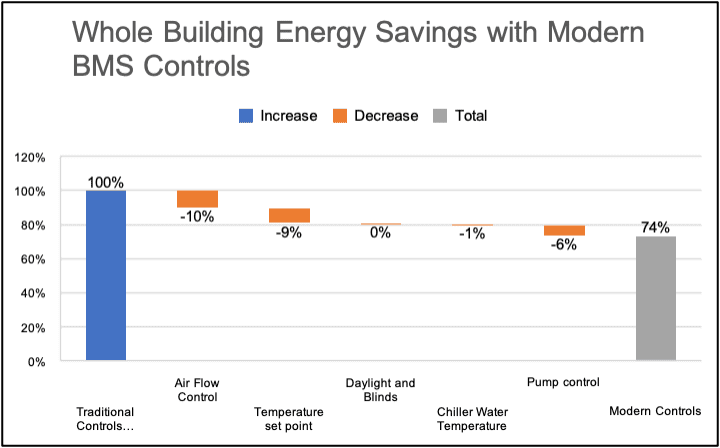Evolving needs in the building industry are driving new demands on owners and building managers. The days of simply ensuring that lights are on and the temperature is tolerable are long gone. Today, in response to global energy regulations and the climate emergency, buildings must deliver better energy performance and lower carbon emissions all while operating efficiently and addressing occupants’ health, comfort, and productivity.

Among the ways building owners can deliver on these needs is with modern building management systems (BMS) and controls. Enriched with increased technical capabilities, data, and IoT protocols, modern systems can be more tightly integrated with multiple systems and applications within a building.
But as they say, ‘the proof is in the pudding.’ So to help us better understand the impact of modern versus traditional controls in delivering buildings of the future, we partnered with Arup, a global industry leader in building engineering services and sustainability analytics. They produced a study quantifying the advantages of modern, connected BMS controls.
The study shows how modern building control technology can:
- Reduce embodied carbon of a BMS and controls, by 23% in this study
- Reduce operational energy and carbon emissions, by as much as 39% for HVAC and lighting
- Reduce whole building energy use intensity (EUI) by up to 26%
- Enable long-term space flexibility and reduce the cost of building space reconfiguration
Comparing BMS performance in a typical office environment
Our study compared traditional and modern building controls in a post-pandemic, hybrid office environment, simulating theoretical commercial buildings in London, UK.
We found three ways modern BMS controls deliver decarbonization and efficiency benefits more effectively and sustainably than traditional systems.
1. Lower embodied carbon and higher return on investment
The study first considered the embodied carbon of a BMS and modern controls using products from Schneider Electric. Product environmental profiles (PEPs) helped validate that modern controls represent lower embodied carbon than traditional control components. Additionally, modern controls can share common cabling, controllers, and other components, thus reducing the amount of materials and embodied carbon.
We then considered the total costs (e.g., capital cost, installation, and commissioning) for traditional vs. modern BMS controls. While modern system controls have a higher initial cost, this is offset by benefits that include, more insightful data about performance, greater system control and flexibility, and the ability to reconfigure controls in spaces faster and easier using software.
2. Reducing operational energy and carbon
The study team also looked at five energy performance scenarios in a side-by-side comparison of traditional vs. modern BMS controls (see graphs below). The study showed that two measures –occupancy-based airflow and temperature setpoint control – performed by modern controls delivered superior operational energy savings and carbon reductions. Airflow is also essential in addressing ventilation standards to improve indoor air quality for healthier buildings. These measures are strongly recommended for new and existing buildings because they are relatively easy and low-cost to implement once a modern BMS is in place.


Assessing the combination of all measures together, the result shows an overall carbon emissions reduction of 39% for HVAC and lighting and an overall 26% reduction in the whole building’s EUI.
3. Greater flexibility to adapt to changing needs
In addition to decarbonization, a modern BMS can help future-proof a facility. A traditional BMS is often siloed with limited system management. However, today’s commercial buildings must deliver more integration and automation.
Modern BMS controls align with the evolving industry requirements I mentioned earlier (efficiency, sustainability, health, comfort) and increased technical capabilities (IoT, cloud computing, AI, analytics). All of these provide additional levels of insight, as well as more granular control at the room level, versus a broad view of an entire floor.
From theory to practice
To learn more about each aspect of our collaborative study with Arup, download the white paper, “Reduce Operational and Embodied Carbon in Commercial Buildings with Modern Building Controls.”
We can also help you on the journey. Discover more about our EcoStruxure™ Connected Room Solutions modern building control solution, including the SpaceLogic™ Insight-Sensor which, with our EcoStruxure Building Operation BMS, can save energy and maintain comfort by adjusting room conditions in near real-time based on precise room occupancy.



